
Benjamin Disraeli, 1st Earl of Beaconsfield, was a British statesman, Conservative politician and writer who twice served as Prime Minister of the United Kingdom. He played a central role in the creation of the modern Conservative Party, defining its policies and its broad outreach. Disraeli is remembered for his influential voice in world affairs, his political battles with the Liberal Party leader William Ewart Gladstone, and his one-nation conservatism or "Tory democracy". He made the Conservatives the party most identified with the British Empire and military action to expand it, both of which were popular among British voters. He is the only British Prime Minister to have been born Jewish.

Edward George Geoffrey Smith-Stanley, 14th Earl of Derby, known as Lord Stanley from 1834 to 1851, was a British statesman and Conservative politician who served three times as Prime Minister of the United Kingdom. To date, he is the longest-serving leader of the Conservative Party. He is one of only four British prime ministers to have three or more separate periods in office. However, his ministries each lasted less than two years and totalled three years and 280 days. Derby introduced the state education system in Ireland, and reformed Parliament.
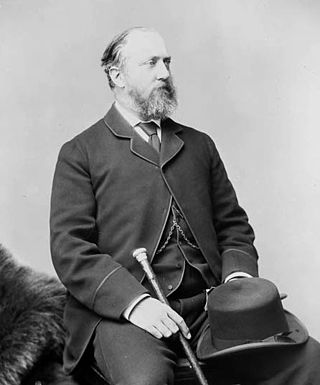
Frederick Arthur Stanley, 16th Earl of Derby,, known as Lord Stanley of Preston between 1886 and 1893, was a Conservative Party politician in the United Kingdom who served as Colonial Secretary from 1885 to 1886 and Governor General of Canada from 1888 to 1893. An avid sportsman, he built Stanley House Stables in England and is famous in North America for presenting Canada with the Stanley Cup, the championship trophy in ice hockey. Stanley was also one of the original inductees of the Hockey Hall of Fame.

Edward Henry Stanley, 15th Earl of Derby, was a British statesman. He served as Secretary of State for Foreign Affairs twice, from 1866 to 1868 and from 1874 to 1878, and also twice as Colonial Secretary in 1858 and from 1882 to 1885.

Gathorne Gathorne-Hardy, 1st Earl of Cranbrook, was a prominent British Conservative politician. He held cabinet office in every Conservative government between 1858 and 1892. He served as Home Secretary from 1867 to 1868, Secretary of State for War from 1874 to 1878, Lord President of the Council from 1885 to 1886 and as Chancellor of the Duchy of Lancaster until 1886. In 1878, he was appointed Secretary of State for India and thereafter was elevated to the peerage, entering the House of Lords as Viscount Cranbrook. He has been described as a moderate, middle-of-the-road Anglican, and a key ally of Disraeli.
The Peelites were a breakaway political faction of the British Conservative Party from 1846 to 1859. Initially led by Robert Peel, the former Prime Minister and Conservative Party leader in 1846, the Peelites supported free trade whilst the bulk of the Conservative Party remained protectionist. The Peelites later merged with the Whigs and Radicals to form the Liberal Party in 1859.

Sir Joseph Edgar Boehm, 1st Baronet, was an Austrian-born British medallist and sculptor, best known for the "Jubilee head" of Queen Victoria on coinage, and the statue of the Duke of Wellington at Hyde Park Corner. During his career Boehm maintained a large studio in London and produced a significant volume of public works and private commissions. A speciality of Boehm's was the portrait bust; there are many examples of these in the National Portrait Gallery. He was often commissioned by the Royal Family and members of the aristocracy to make sculptures for their parks and gardens. His works were many, and he exhibited 123 of them at the Royal Academy from 1862 to his death in 1890.

The Conservative government of the United Kingdom of Great Britain and Ireland that began in 1866 and ended in 1868 was led by Lord Derby in the House of Lords and Benjamin Disraeli in the House of Commons.
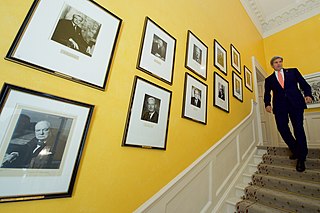
The article lists the records of prime ministers of the United Kingdom since 1721.

Benjamin Disraeli was appointed Prime Minister of the United Kingdom for a second time by Queen Victoria after William Ewart Gladstone's government was defeated in the 1874 general election. Disraeli's foreign policy was seen as immoral by Gladstone, and following the latter's Midlothian campaign, the government was heavily defeated in the 1880 general election, whereupon Gladstone formed his second government. The ailing Disraeli, by now created Earl of Beaconsfield, died in April 1881.

The leader of the Conservative Party is the highest position within the United Kingdom's Conservative Party. The current holder of the position is Kemi Badenoch, who was elected to the position on 2 November 2024, following her victory against Robert Jenrick in the party's leadership election.
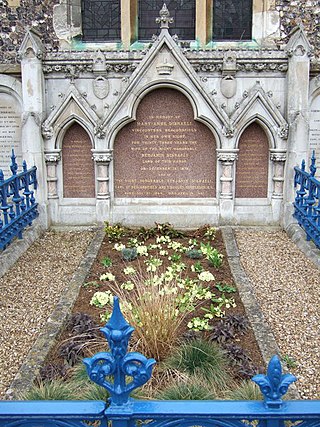
Primrose Day marked the anniversary of the death of the British statesman and prime minister Benjamin Disraeli, 1st Earl of Beaconsfield, on 19 April 1881. The day was marked each year into the 1920s, with arrangements of primroses left at Disraeli's tomb at St Michael and All Angels Church, Hughenden and his statue in Parliament Square and many supporters wearing primroses as buttonholes, garlands, and hat decorations.

The statue of the Earl Kitchener is an outdoor bronze statue by John Tweed depicting Herbert Kitchener, 1st Earl Kitchener, installed in 1926 and located on the south side of Horse Guards Parade in London, United Kingdom. The sculpture stands on a Portland stone plinth. It became a Grade II listed building in 1970.

The statue of Benjamin Disraeli is an outdoor bronze sculpture by Mario Raggi, located at the west side of Parliament Square in London. It was unveiled in 1883 and became a Grade II listed building in 1970.
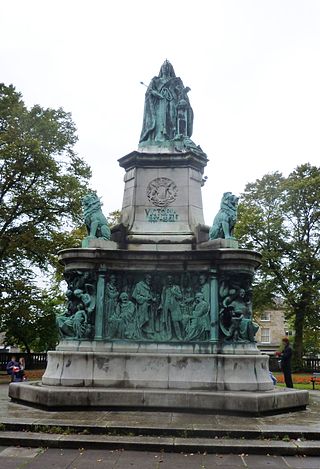
The Queen Victoria Memorial in Lancaster, Lancashire, England, is a Grade II* listed building. It stands in the centre of Dalton Square, facing Lancaster Town Hall. It was erected in 1906, being commissioned and paid for by James Williamson, 1st Baron Ashton.

A bronze statue of Admiral of the Fleet Louis Mountbatten, 1st Earl Mountbatten of Burma is located on Mountbatten Green, off Horse Guards Road, Whitehall, London, England. The sculptor was Franta Belsky and the work was cast by the Meridian Bronze Foundry. The memorial was unveiled on 2 November 1983.
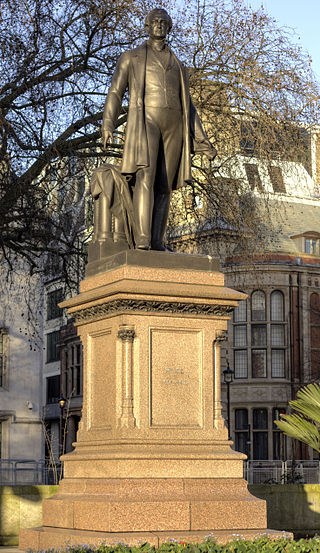
The statue of Robert Peel in Parliament Square, London, is a bronze sculpture of Sir Robert Peel, a former prime minister of the United Kingdom. It was sculpted by Matthew Noble and was one of the first three statues to be placed in the square.
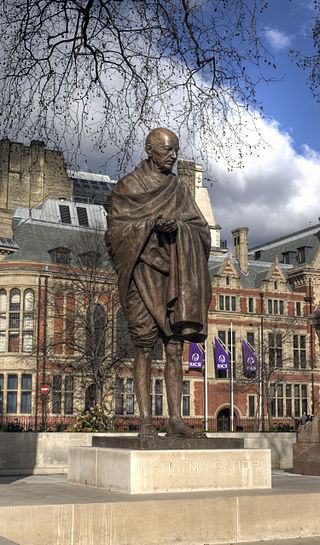
The statue of Mahatma Gandhi in Parliament Square, Westminster, London, is a work by the sculptor Philip Jackson.

A life-size bronze statue of Jan Smuts by the British artist Jacob Epstein stands on the north side of Parliament Square in London, United Kingdom, between a statue of Lord Palmerston and a statue of David Lloyd George.




















